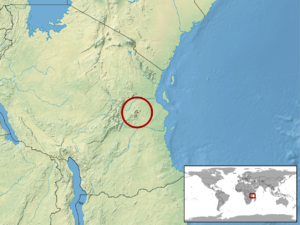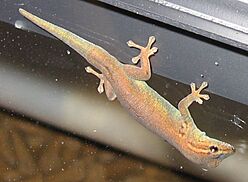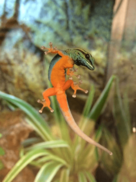Electric blue gecko facts for kids
Quick facts for kids Electric blue gecko |
|
|---|---|
 |
|
| Male | |
 |
|
| Female | |
| Conservation status | |
| Scientific classification | |
 |
|
| Lygodactylus williamsi is restricted to a few square kilometers of Tanzania. |
The Lygodactylus williamsi is a very special type of lizard in the gecko family. It is also known as the turquoise dwarf gecko or electric blue gecko. This amazing gecko only lives in a small part of Tanzania, a country in Africa.
Sadly, this gecko is critically endangered. This means it is at a very high risk of disappearing forever. Many of these geckos are caught illegally from the wild and sold as pets. Even though it is against the law, this still happens a lot.
Good news! These geckos can be raised in special breeding programs. Zoos and other groups are working to breed them safely. This helps protect the species without taking them from their natural homes.
In 2017, new rules were made to protect the electric blue gecko. It is now very hard to keep or sell them without special papers. This helps stop the illegal pet trade.
Contents
Why the Electric Blue Gecko is Endangered
The biggest danger to the Lygodactylus williamsi is people catching them illegally. They are taken from the wild to be sold as pets around the world. Because of this, their numbers are dropping very quickly.
Even though it is illegal, many wild geckos are still sold in pet shops. Experts believe that tens of thousands of these geckos were taken from the wild in just a few years. This was about 15% of all the geckos living in the wild at that time.
However, some people are working hard to breed these geckos. They are learning how to raise healthy geckos in captivity. Geckos born in these programs are used to human care. This is much better than taking them from the wild, which can be very stressful for them.
Where They Live
The Lygodactylus williamsi lives in a very small area in eastern Tanzania. This area is only about 8 square kilometers (about 3 square miles). They live in places like the Kimboza Forest and other nearby forest reserves.
In 2009, scientists thought there were about 150,000 adult geckos in the Kimboza Forest. We do not know how many are in other places. Some of their homes outside protected areas are very tiny. For example, one place only has 14 special trees left because the rest of the land was cleared for banana plantations.
Their Home in the Wild
In nature, the turquoise day gecko lives only on a special tree called the screwpine, or Pandanus rabaiensis. They mostly live in the top part of the tree, among the leaves. They prefer large trees with long leaves.
Usually, one tree will have one gecko, or a male, a female, and their young. These geckos eat small insects. They also drink water from the leaves and enjoy eating nectar from flowers.
Losing Their Home
One big problem is that collectors often cut down the screwpine trees. They do this to reach the geckos living in the leaves. This destroys the gecko's home. Many geckos also die when they are shipped to pet markets. The illegal pet trade is a bigger threat than just losing their habitat.
The forests where L. williamsi lives are also getting smaller. They are being cut down for farms and for wood. Fires happen more often, and people are mining for valuable rocks like rubies and gold. All these things hurt the gecko's home. Even new types of trees growing in the forest can be a problem. There is not much forest left that is safe for them.
What They Look Like
Male L. williamsi geckos are a bright blue color. They have dark stripes on their throats. Female geckos can be brown, bronze, or bright green. They usually do not have much black on their throats. Young males can look like females, as they are often green too.
Both male and female geckos have orange undersides. Their colors can change depending on their mood or how warm or cold they are. Males can turn from black or gray to a brilliant electric blue. Females can go from dark brown to a bright green with blue hints. Adult geckos are about 5 to 8 centimeters (2 to 3 inches) long.
There is a guide online that helps people tell these geckos apart from other similar species. This guide is mostly for customs officers to help them spot illegal shipments.
How They Behave
Like other geckos in their group, L. williamsi geckos are active during the day. They are brave, busy, and like to be around other geckos. Male geckos are territorial. This means they usually do not like other males in their space.
They show how they feel by flattening their bodies, puffing out their throats, shaking their heads, and wagging their tails.
How They Reproduce
Male L. williamsi geckos try to attract females by flattening their bodies and puffing out their throats. They also bob their heads. About two to three weeks after mating, the female lays one or two small, white, hard-shelled eggs. She glues these eggs to a hidden surface to keep them safe.
The eggs hatch in about 60 to 90 days.
How They Got Their Name
The name williamsi was given to this gecko by a British zoologist named Arthur Loveridge. He named it after an American expert on reptiles, Ernest Edward Williams.




